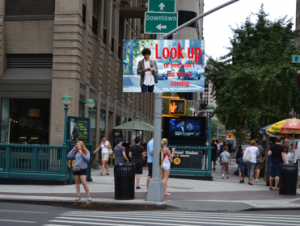Cell Phones as a Distraction to Pedestrians
Cell phone distraction is a vital issue as solving small scale problem within it, such as pedestrians crossing the street, will actually make a large impact and help prevent accidents and save lives. To bring this proposal into New York City would take approximately a year with costs involving materials, construction, and advertising. Once solved however, pedestrian traffic will decrease on the sidewalks, commutes will become faster, citizens will be more aware of the dangers of cell phone use and ultimately, lives will be saved.
Perhaps we don’t realize it but we see it nearly every day: cell phone use on the streets and sidewalks. I can’t say I’m immune to it either, I’ve found myself bumping into someone because I’m too busy texting. Have you ever gotten a text right before crossing the street and just had to look at it? Do you see your walking commute to work the little bit of free time out of your day? So getting those texts and emails out seems like a good way to make use of time? The excuses seem valid until accidents happen, which they too often have. In protecting the people of New York City, it is important to raise concern over this issue and create solutions rather than just watch it happen before us.
According to the National Highway Traffic Safety Administration, there were about 5,000 deaths and 76,000 injuries in traffic collisions in the United States in 2012. And since 2009, pedestrian deaths have increased to about 51% of all injuries in New York City, mostly caused by distracted walking.[1] Now put distracted pedestrians on the same street as our distracted drivers too, two large issues on the same playing field. And if nearly 29.8% of all pedestrians are distracted while crossing the street[2], it simply gets dangerous, no less slows down the sidewalk rush and causes more traffic and bumping into. It’s a difficult issue as we can’t exactly tell people they can’t use their phones when they walk outside; there is no way for one to own that walking space and what goes on in it. However, there may be ways to at least encourage people to pay more attention to where they’re walking, or to separate those who want to use their phones and walk slowly and those who walk quickly with no distractions. I have observed habits of pedestrians myself. People can stare down at their cell phone for for about ten seconds before looking up. Sometimes it takes a physical bumping into to realize they are in people’s way. Additionally, I have timed my commute down the block when using a phone texting somebody versus looking up and paying attention weaving through traffic. The difference was about twenty seconds, and I was one less distracted person, getting myself out of the way of other people commuting and keeping myself safe.
The solved problem is this: a filter of cell phone users on the sidewalks, allowing for express lanes for those not using them. Commutes will be faster and smoother, and pedestrians will be using one side of the sidewalk for each direction, avoiding even natural collisions without cell phone use. Additionally, cell phone users will put their phone down when crossing the street, looking up to keep themselves and others around them safe. This will allow people to cross the street faster and safer, increasing the overall flow of pedestrians.
It will be important first to observe people’s habits on the streets of New York City. We will note just about how many people have their heads down texting, which side of the street they move to avoid people while they’re distracted versus when they’re not, and how much they actually slow down when distracted by their phone. I would observe those who text versus those who talk on the phone to see if talking on the phone still distracts enough to cause traffic or not. It would also be important to see how people tend to avoid other people on the sidewalk: how long they wait to avoid, which side they go to, and even which side on which people pass others. This way I can start thinking about the sidewalk itself and how to design that in a way to allow for smoother commuting. This needs to be done during rush hour to examine the maximum population travelling, and also at some major business spots or simply popular areas such as Union Square, Columbus Circle, the Financial District, and Times Square.
In accordance with this research we will be able to determine the correct way to redesign the sidewalks to create the best commuter flow. Painting lanes on the sidewalks will filter the cell phone users, essentially building an express-lane for pedestrians. Not only will this separate those not using their phone and thus decreasing their commute time, but it will also be a method to make people aware of what everyone seems to be doing wrong on the sidewalks. Second, I believe pedestrians need another means to be aware of these dangers with a bold advertisement right where they will (hopefully) look to cross the street: above the walking signal. Many times, consumers won’t change until they are scarred or an accident happens. A partnership with the MTA for these ads would be beneficial as a message from them speaks to New Yorkers almost personally, they most likely use public transit almost every day. The MTA would benefit from sending an advantageous message.
Along with partnership with the MTA, we will need a printing company to print the ads along with workers to install them. In regard to the sidewalk reconstruction, construction workers, paint, and signs. Work would be best to be done at night where there are the least amount of people walking, that way we do not cause more traffic by trying to ultimately decrease it. We would need approval from the city for installation of the ads and for the changes of the sidewalk, and perhaps a permit as well. LOOK UP. Ads will be installed first, to begin the awareness process while sidewalk changes will begin in Midtown and work its way out, hitting the most populated areas first.
After researching past costs of lane painting and sidewalk infrastructure, paining lanes on the sidewalk would cost approximately $6-$10 per square foot for the lines, and about $500-$1,000 for each symbol designating each lane[3]. Additionally, the ads to be hung on the street sign will cost approximately $360 each month per banner[4].
As a commuter myself, phone distraction is a habit of mine too, but I have seen the results of avoiding it and I believe that increasing that will increase flow and save lives of fellow New Yorkers. New York City is known for its traffic and congestion, and after knowing the statistics of this issue, it is an area that needs increased awareness and safety.
Upon finalization of this project, security cameras will help us capture the difference in commuter traffic, and perhaps human counting along sidewalks and comparing travel times will reveal the improvement of pedestrian traffic. In long term measurement, we will observe the number of pedestrian deaths and injuries to compare it to the past. This project not only will better pedestrian traffic in New York City, it will also raise awareness to an issue that has not been addressed enough as cell phone have literally been swallowing up our lives.
Bibliography
Bushell, Max et al. “Costs For Pedestrian And Bicyclist Infrastructure Improvements”. pedbikeinfo.org. N.p., 2013. Web. 14 Mar. 2017.
Church, Nate. “Danger of ‘distracted walking’ While Using Cell Phones on the Rise.” December 31, 2015. Accessed February 15, 2017. http://www.breitbart.com/tech/2015/12/31/danger-of-distracted-walking-while-using-cell-phones-on-the-rise/.
Glassberg, Brooke. “New Ad City-Breaking Down The Cost Of Getting Our Attention”. nymag.com. N.p., 2017. Web. 14 Mar. 2017.
McCormack, Caitlin. “Distracted Walking a Major Pedestrian Safety Concern.” September 1, 2015. Accessed February 15, 2017. https://www.safety.com/blog/distracted-walking-a-major-pedestrian-safety-concern/.
Waxman, Olivia B. “Walk and Don’t Talk: Pedestrians Distracted by Mobile Phones | TIME.Com.” December 19, 2012. Accessed February 15, 2017. http://healthland.time.com/2012/12/19/walk-and-dont-talk-pedestrians-distracted-by-mobile-phones/.
[1] McCormack, Caitlin. “Distracted Walking a Major Pedestrian Safety Concern.” September 1, 2015. Accessed February 15, 2017. https://www.safety.com/blog/distracted-walking-a-major-pedestrian-safety-concern/.
[2] Waxman, Olivia B. “Walk and Don’t Talk: Pedestrians Distracted by Mobile Phones | TIME.Com.” December 19, 2012. Accessed February 15, 2017. http://healthland.time.com/2012/12/19/walk-and-dont-talk-pedestrians-distracted-by-mobile-phones/.
[3] Bushell, Max et al. “Costs For Pedestrian And Bicyclist Infrastructure Improvements”. pedbikeinfo.org. N.p., 2013. Web. 14 Mar. 2017.
[4] Glassberg, Brooke. “New Ad City-Breaking Down The Cost Of Getting Our Attention”. nymag.com. N.p., 2017. Web. 14 Mar. 2017.

